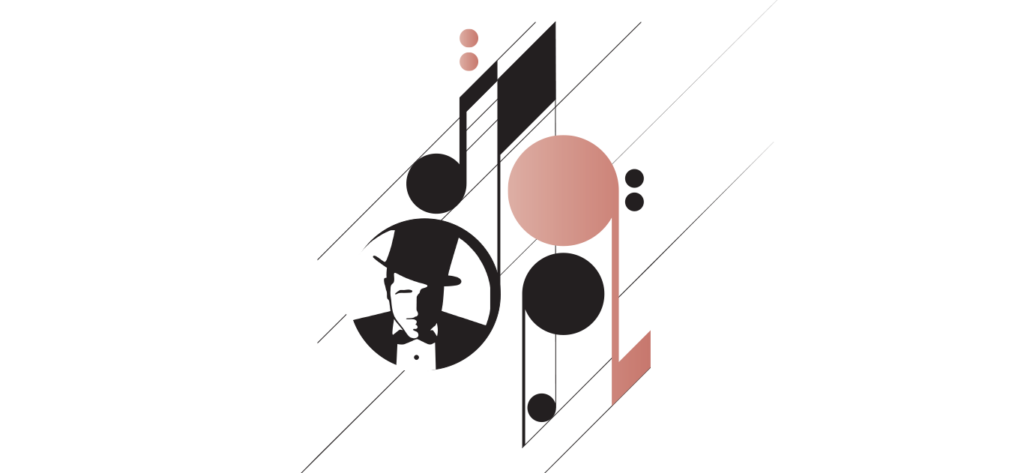
Sun Prairie, Wisconsin, may not sound like a place you’d find a big band’s worth of avid young jazz musicians. The name evokes the bright wide-open spaces of grazing lands, not the dim and cramped confines of an urban jazz joint. And yet, here we are in the Louis Armstrong rehearsal room of New York City’s Jazz at Lincoln Center, and 17 Midwestern teenagers are tearing their way through Duke Ellington’s 1932 version of the hot-jazz number “The Sheik of Araby.” This is their last run-through before they perform in the “Essentially Ellington” competition for top high-school jazz bands from all across the country.
Founded in 1995 by trumpeter Wynton Marsalis, with financial support from philanthropists like Jack Rudin, the competition is in its 23rd year. More than 100 bands from places as disparate as West Hartford, Seattle, and Tucson submitted audition tapes for this year’s event. The top 15 were invited to Manhattan to see who can most convincingly play the music of Duke Ellington and other important jazz composers. The Essentially Ellington program provides not only a grand final playoff in one of the great citadels of jazz, but also assists bands throughout the year to tutor players, coach directors, and gives them arrangements of music from a specially created library of classic jazz compositions. Without the effort of Essentially Ellington to distribute this music and training to the next generation of musicians, many of these great art pieces would be lost to history.
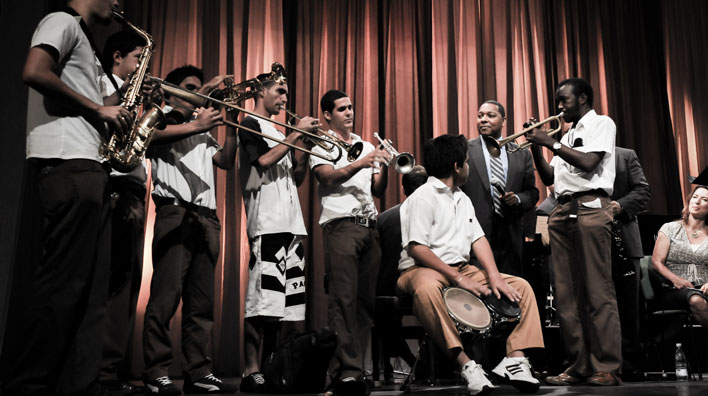
Thanks partly to this year-long assistance, the Sun Prairie High School Jazz Ensemble plays well. Remarkably well. What’s astonishing is how authentic and polished the band sounds. Like many of the other finalists, it has captured the instantly recognizable idiom of Duke Ellington’s orchestra, a sound that requires not only excellent musicianship but sophisticated articulation, timbre, and vibrato.
Today’s typical modern jazz horn player has an austere tone marked by an absence of vibrato. Not so the trumpets, trombones, and (especially) saxophones of the Swing Era, when vibrato was an essential part of a band’s sound. The vibrato of the Glenn Miller Orchestra’s saxophones made the band shimmer. Count Basie’s saxes had an easy and agile vibrato fitting a swinging dance band that was light on its feet. But no band’s vibrato was as distinctive as that of Duke Ellington’s reed section: unapologetically broad, muscular, and romantic.
Kyra Devlin plays lead alto saxophone with Sun Prairie. She’s headed to Michigan State in the fall, where she plans to keep playing jazz—though her primary instrument is the bassoon. When it comes to the saxophone, she says, “All I listen to is Johnny Hodges,” Ellington’s alto soloist for the better part of half a century.
It’s more common for young jazz musicians to gravitate toward idols with the fleetest fingers. Bebop and post-bop ideals favored velocity, often producing music with all the subtlety of a machine-gun burst. For ambitious teens eager to prove their technical mastery, it’s sometimes hard to recognize that simpler lyricism can be a greater achievement than racing up and down scales. Exposure to the music of Ellington teaches the crucial difference between mere virtuosity and true artistry. It’s a lesson Devlin has learned well. “I’d rather play deep emotional music than lots of notes,” she says.
One of this year’s competition pieces is a ballad that Ellington wrote as a showpiece for Johnny Hodges. When the contest begins, one after another young performer attempts something that takes courage—trying to approximate the heartbreaking expressiveness with which Hodges played the piece. This is music that deepens our understanding of life. It gives us tools to grapple with longing, love, and loss. Practicing and performing it teaches something to teens who are otherwise barraged with music that only reinforces the immature instincts of adolescence.
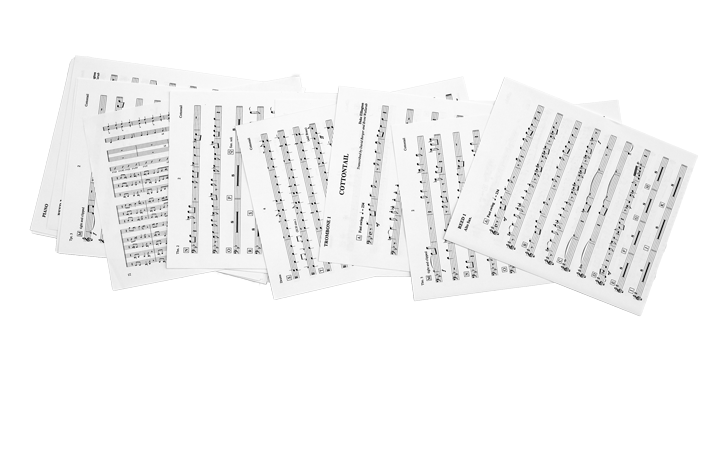
With donor support, Essentially Ellington has taken on the expensive task of producing accurate transcriptions of Ellington’s songs, creating multi-part scores that future generations can use to keep the music alive.
Musical sportsmanship
From the belters of “American Idol” to the various prodigy-olympics for classical kids, there is no shortage of music competitions today. Student jazz festivals, though competitive, are generally tempered by the fraternity of shared participation in a very specialized endeavor. This is particularly true of the Essentially Ellington competition, which consciously marries rarefied performance with an ethic of mutual support and deep respect for the musical tradition.
When Susan Rudin, co-chair of the festival, takes her friends to the competition, she finds that two things in particular capture their attention and spark enthusiasm. The first is the quality of the music—the students’ playing is truly first-rate. The second revelation is the behavior of the high-schoolers. When not on the Rose Theater stage themselves, all of the competitors are out in the auditorium applauding their rivals. And it’s not a stingy, begrudging sort of cheering. As each band finishes its performance it is met with a roar of approval from hundreds of teens on their feet. Noting that these ovations go far beyond the obligatory handshakes exchanged by opposing athletic teams, Rudin observes the irony that music would provide this pure form of sportsmanship.
“They’ve all been supportive and kind,” says Kobe Conomon of his fellow competitors. He is a drummer with the Osceola County School for the Arts, a Florida band that has made it to the finals several years. “We’re all here for the same reason,” he says, “to play jazz.”
The players are encouraged in this direction at every turn. “A competitor is not an enemy,” Marsalis tells them. “Don’t hate—congratulate!”
The enthusiastic student cheering sometimes poses a challenge for the judges. The bands that have played best are not always the ones that have most excited the crowd, says judge Jeff Hamilton, a drummer and bandleader whose many credits include touring with Oscar Peterson. “We have to be fair on talent, not being swayed by who lit up the house,” Hamilton says. They hope to teach the young players to distinguish between showy flash and performances that are in service to what the music demands. “Sometimes the house goes crazy, but not for musicianship.”
A large cadre of jazz professionals like Hamilton make the Essentially Ellington formula work. In addition to the judges at the New York City festival there are those who choose the 15 finalists from the 109 groups that submitted tapes last year. And, most important, there are the musicians from the Jazz at Lincoln Center Orchestra who travel to scores of schools every year to tutor and coach.
The traveling clinicians offer broad lessons in musicianship—phrasing, dynamics, articulation—but also specific expertise in performance peculiar to the Swing Era. For example, the style of guitar playing that was standard with the big bands was nearly wiped out by the invention of the electric guitar. The Lincoln Center band has one of the few remaining masters of that earlier art, guitarist James Chirillo. He ranges to high schools across American giving master classes in big-band rhythm-guitar technique, and tips on early-jazz banjo styles too. This year, the Essentially Ellington program has sent out more than 40 clinicians.
Tutoring continues right up to the day the competition begins. On a Friday morning just hours before the first band will take the stage, I watch Marcus Printup, a trumpet soloist with the Jazz at Lincoln Center Orchestra, help calm a group of high-strung high-schoolers. After they run through one of the pieces they’ll perform later that day, their director gently urges them to critique what they could have done better. Printup cheers them on, asking instead what they liked best about their performance and want to hang onto.
Working with eager young musicians is inspiring, Printup tells me later. “Look at all the work they put into this,” he says. “They are so hungry.” He says these exchanges “make me a better musician too.”
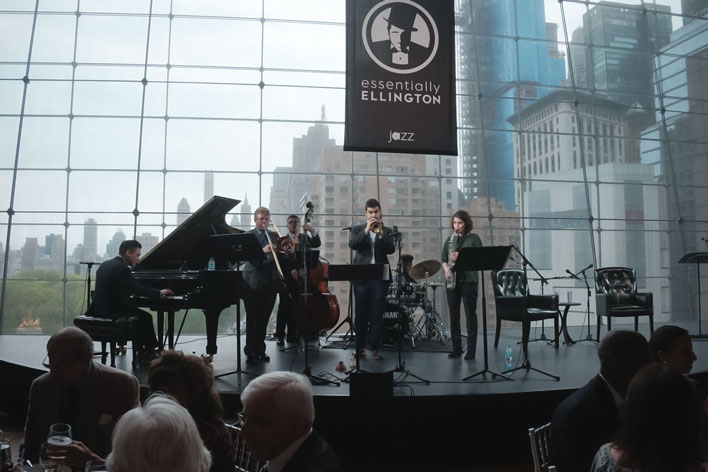
Back to the classics
At many jazz-band competitions, you’ll mostly hear modern music by contemporary arrangers. That is very different from classical competitions, where players strive to do justice to the work of recognized master composers. Why don’t more jazz bands perform authentic jazz classics? Part of the problem is that most of the music performed by the great orchestras of the big-band era was never published. And what became commercially available was often dumbed down to make it playable by journeymen and amateurs. (The Artie Shaw band’s “Begin the Beguine,” for example, was transposed down a step from the original recording, in the expectation that non-virtuoso clarinetists would struggle and squawk if required to play Shaw’s soaring high notes.)
So how has the Jazz at Lincoln Center organization run a major festival devoted to teaching and perpetuating Duke Ellington’s music, when few of his original arrangements were ever published? Thanks to the financial support of donors, the group has undertaken a massive project to produce complex musical scores—“charts” in jazz jargon—that high-school students (and other players) can then use to learn the authentic Ellington style.
This requires scrounging for bleary ninth-generation photocopies of working arrangements, digging through music museums for rare surviving scores, and, most of all, making transcriptions from recordings—the difficult process of reverse-engineering music by listening over and over to old records in order to write down the notes played by each instrument. Each year a different set of eight songs by the Duke and other master composers of the golden age of jazz, carefully written out in multi-instrument parts, is made available to any high-school band that wants the music. If a group decides to take part in the competition, it must perform several of that year’s selections.
By putting large effort and resources into these various processes of reclaiming great old songs for future players, the Essentially Ellington competition is not only providing high-schoolers with the raw material needed for each year’s competition, but also making classic jazz readily available to future musicians in definitive editions. “Prior to Essentially Ellington, there were about five original Ellington charts available,” says Todd Stoll, Jazz at Lincoln Center’s vice president for education. “There would be versions of Ellington songs, but not the actual charts as written by Duke. Wynton Marsalis wanted to create and publish accurate editions.”
“Duke Ellington’s music represents one of the highest points of American culture,” Stoll continues. “We wanted to make editions that stand the test of time.” To bring the widest number of students into contact with the music, Lincoln Center distributes the arrangements to schools for free. This past year, thanks to its donor support, Essentially Ellington gave away 42,000 charts.
This project has also inspired upstart publishing companies to get in the game, with new transcriptions (some excellent, some of indifferent quality) coming on the market every month. The proliferation of classic charts has even encouraged those with their hands on original scores to finally make them available for publication.
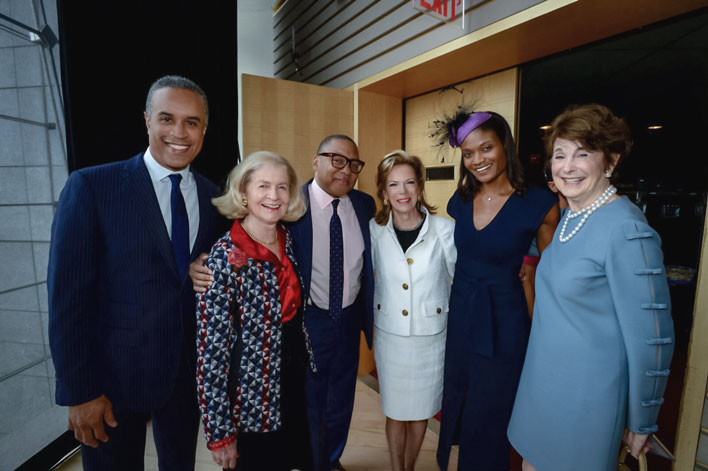
Art speaks across time
Gail Engelberg has been on the Jazz at Lincoln Center board for 15 years. Growing up in New Orleans, she had a natural affinity for the music, and in college she studied arts and education. After she graduated she went into the decidedly non-artsy business of buying up scrap steel from railroad salvage yards, at which she was very successful. Now she combines her business savvy with her love of music by financially supporting Jazz at Lincoln Center and the Essentially Ellington program.
She enjoys providing resources to individuals who have the ability to do remarkable things with them. As a donor, Engelberg says, “I discovered there are good programs that struggle because they lack leadership, and there are leaders without a good program.” The jackpot comes when “strong leaders combine with strong programs.”
Essentially Ellington, headed by Wynton Marsalis, is just such a combination. The trumpet prodigy developed Jazz at Lincoln Center into a mature and robust institution, with an annual budget of $43 million, and the Ellington competition as one of its crowning successes. Nearly $5 million was devoted in 2017 to the Essentially Ellington program and related jazz education efforts. Major support for Jazz at Lincoln Center comes from the Hearst, Augustine, Ella Fitzgerald, and other foundations. But the institution also relies on a bevy of individual donors who give from $250 to $25,000.
Like many of the best nonprofit leaders, Marsalis never forgets the importance of funders. After all the high-school bands have performed each year, and the students are gathered waiting to hear from the judges which finalists have won the top prizes, Marsalis makes them stop for a moment to hear, amidst their anxious anticipation, why the top trophy is named for the late Jack Rudin. A builder of Manhattan apartment buildings, Rudin and his family business partners achieved a reputation for generosity across a wide range of New York City causes. He and Wynton Marsalis became friends, often meeting for breakfast to plot how to build a lasting jazz edifice.
“Jack Rudin,” Marsalis tells the students, “made it possible for us to begin Essentially Ellington. He was a World War II veteran and a man of great dignity and intelligence and engagement. His wife Susan carries on the legacy for this festival. It’s very important at all times to recognize Jack. We would not have gotten this off the ground if it were not for him.”
There’s one last part to the lesson in gratitude. Marsalis calls all of the band directors to the stage and has the assembled crowd of kids raise the roof in appreciation of their effort and personal sacrifice. “Remember one thing,” Marsalis says after the cheering finally fades. “We are a country that constantly separates younger people from older people…. Remember the feeling we had in here tonight. The generation gap is not real. Understand: We’ve got to come together out here. I love what you all showed us. It lifted all of our spirits. Thank you for what you’ve given to this music and to us.”
In other instances Marsalis might add that we live in a time constantly trying to separate people of one race and ethnicity from another. The Essentially Ellington festival also shows young people how to close those gaps. Students of many backgrounds pour themselves into performing the music of an African-American icon. There’s no griping about “cultural appropriation.” Instead there is shared celebration of the universality of great art, art that transcends fads and ideologies and backgrounds. “Regardless of race or gender,” says Stoll, “art speaks across time.”
Just before the last day’s performances, I run into three high-school band directors from Flathead County, Montana. They have no entry in the festival but have come to observe, in the hope they can put together a regional student jazz band to compete in coming years. Bringing a bunch of young players from rural Montana to New York will probably require help from donors. But if their local citizens offer support, and the local kids put in the effort to learn and practice, they will find a wonderful structure in place that helps boost them to new heights. Thanks to earlier donors, there is a whole mechanism capable of taking the dreams of those directors, and the energy of their students, and transforming them into mastery of a great American art form.
